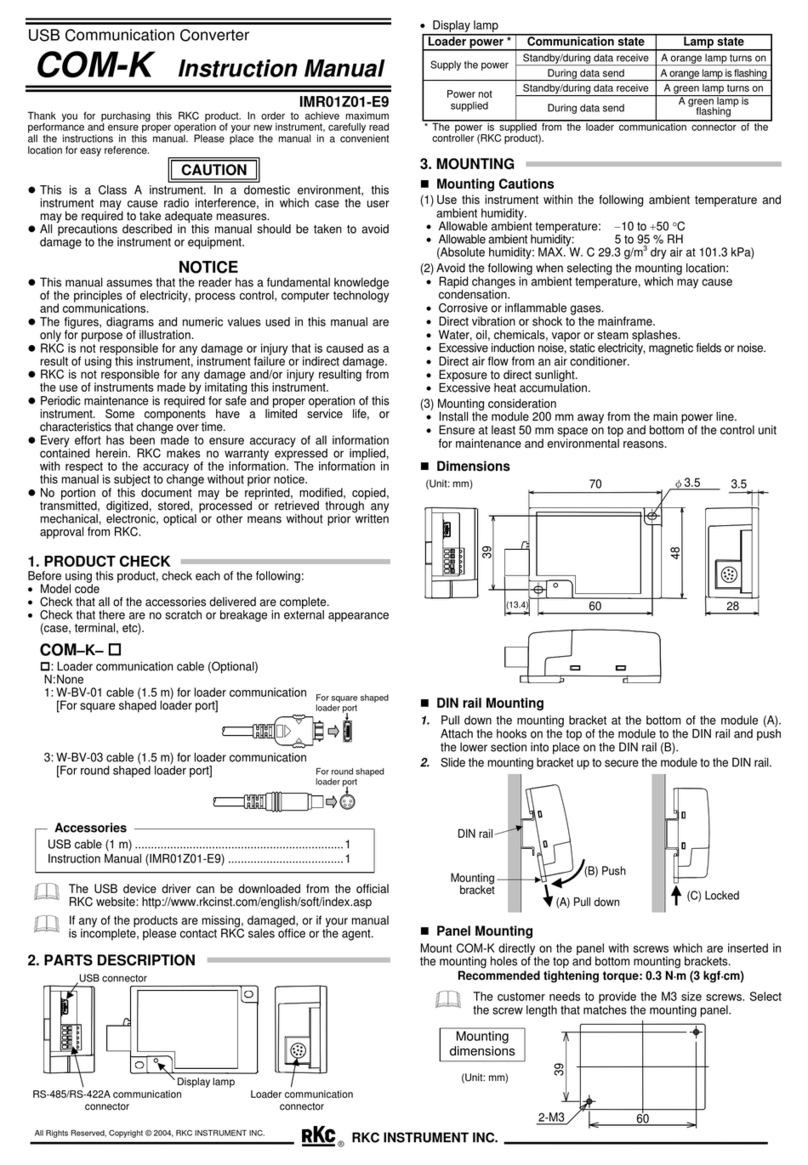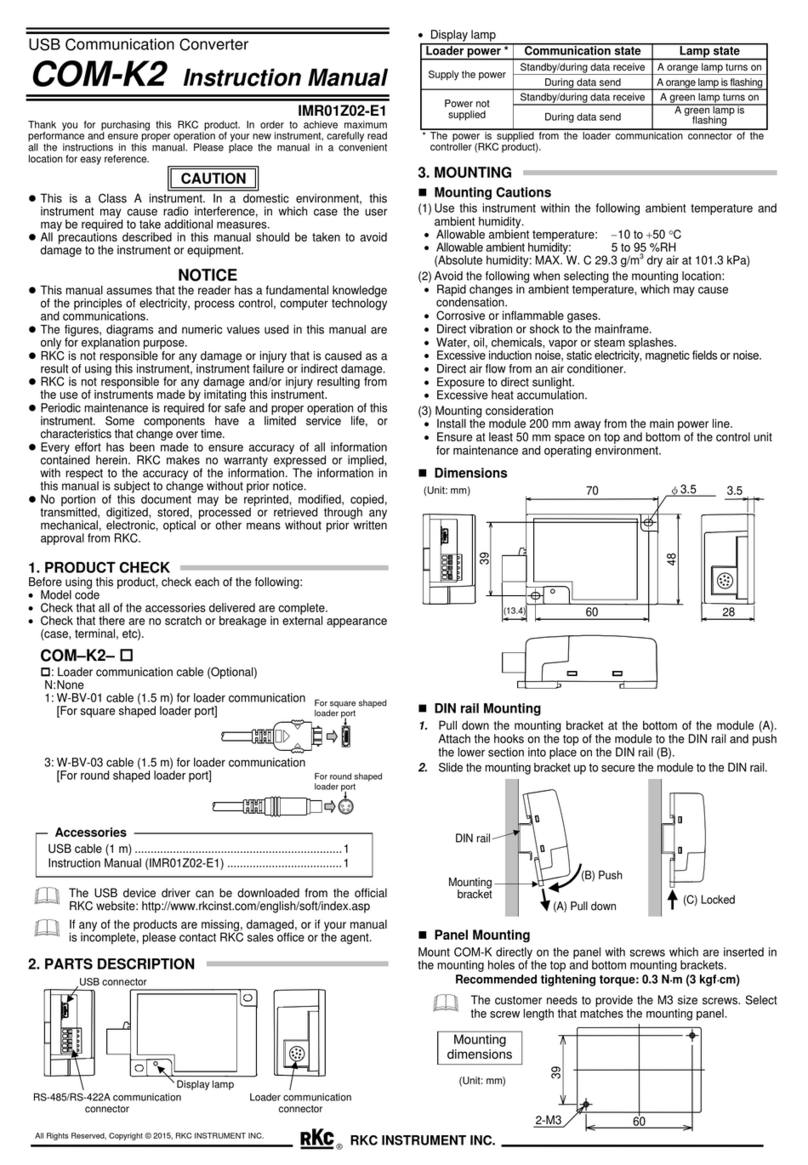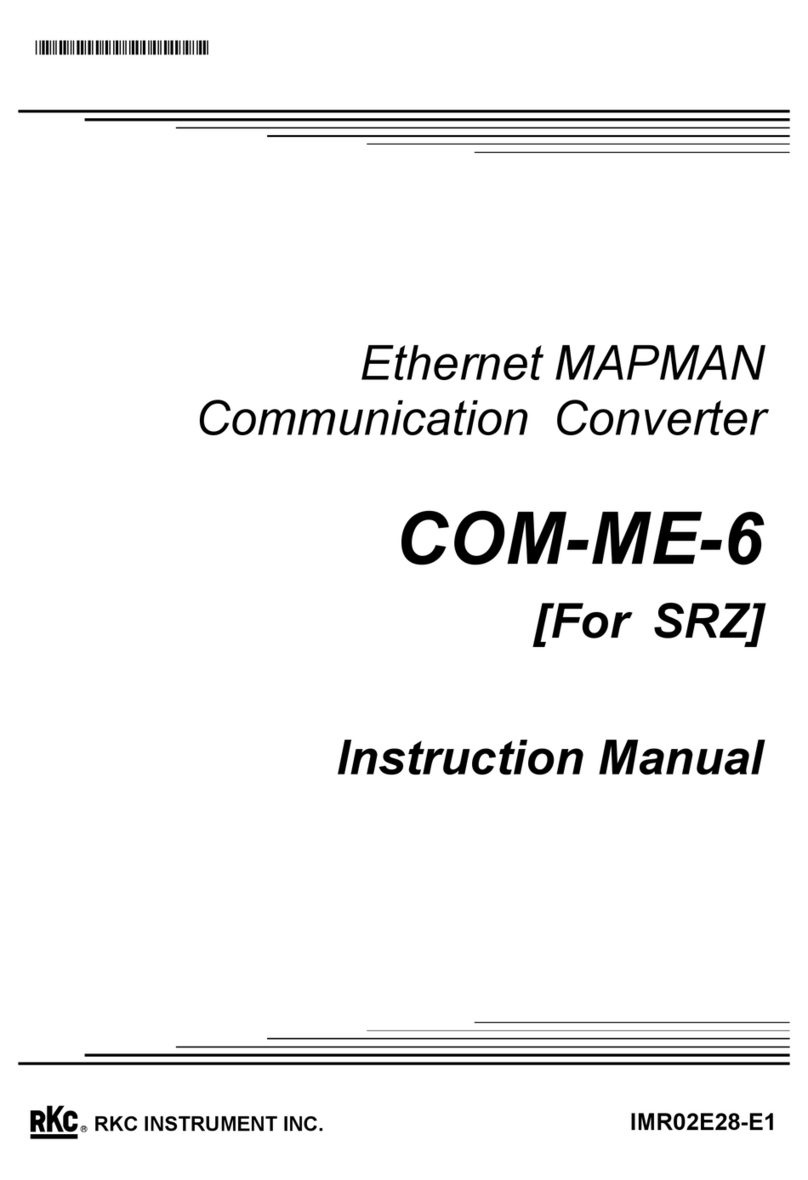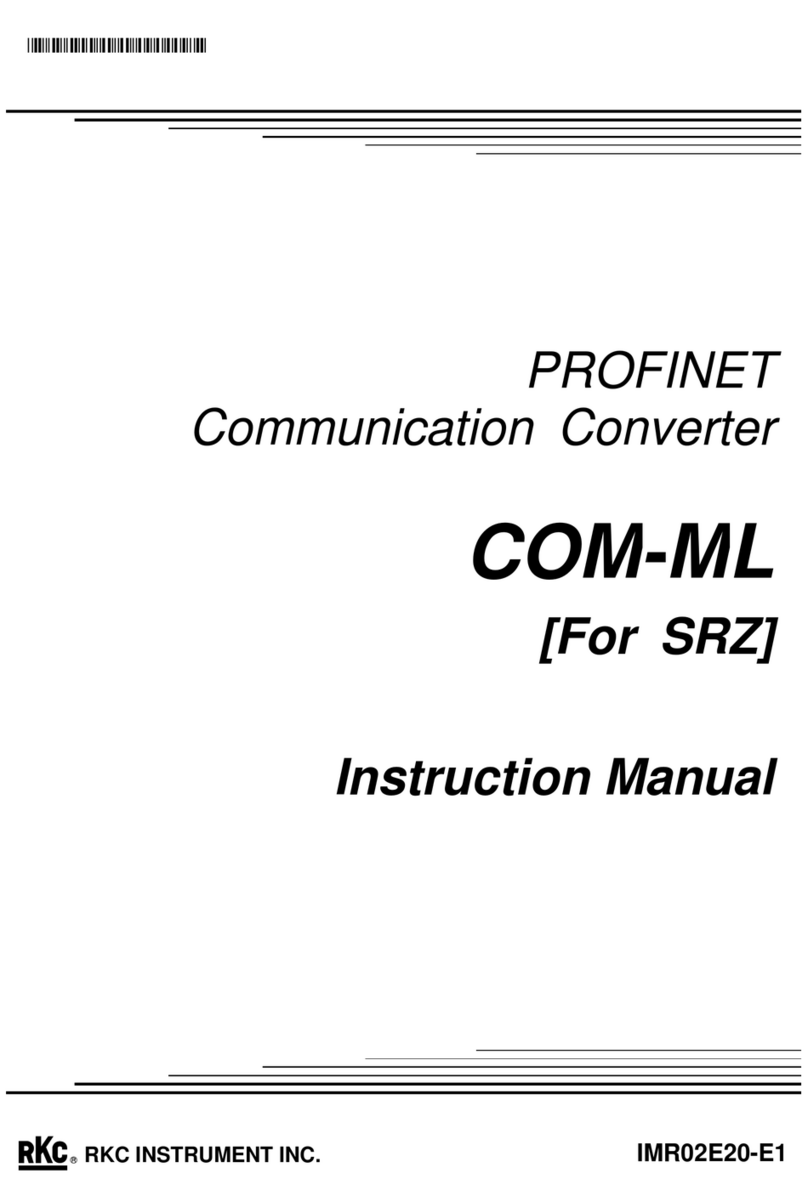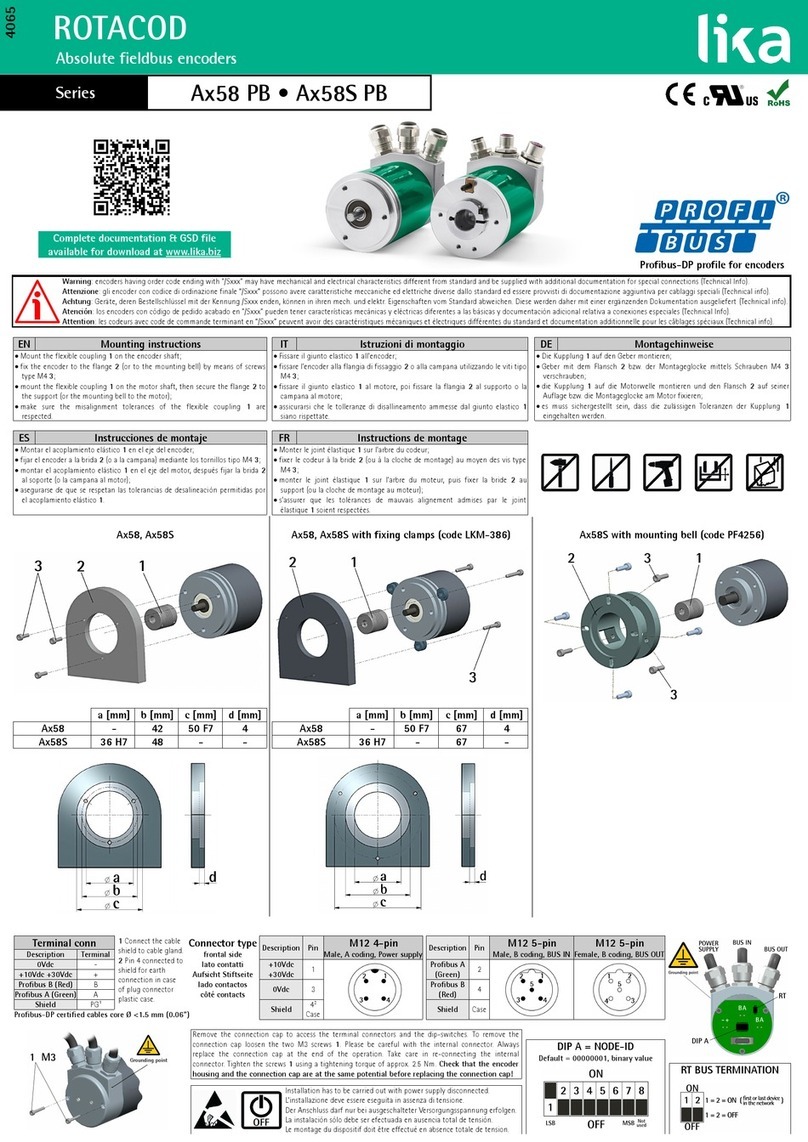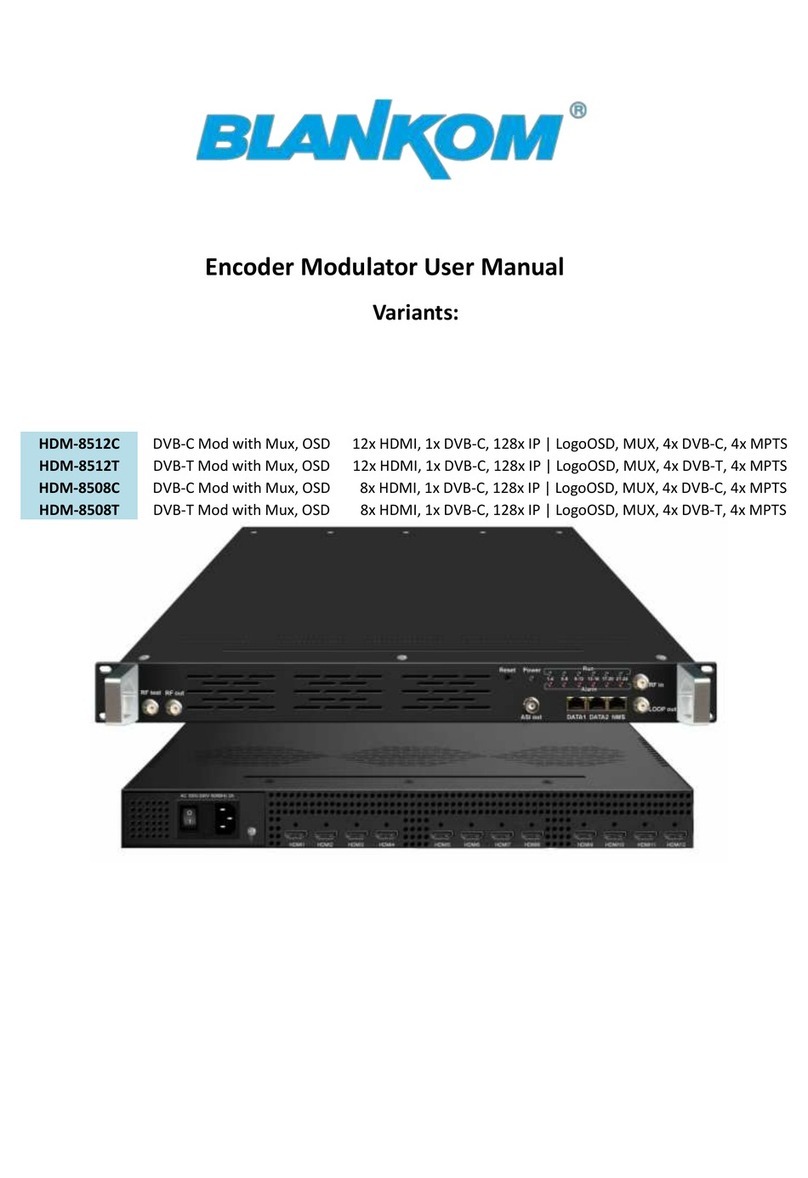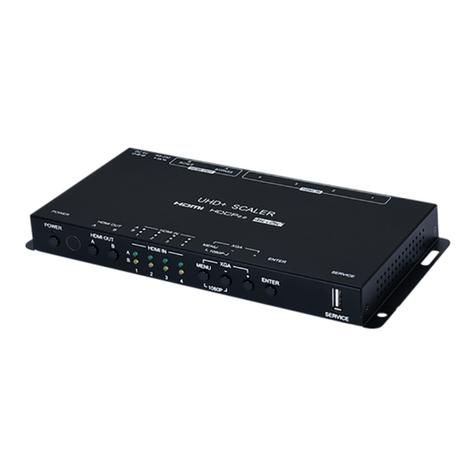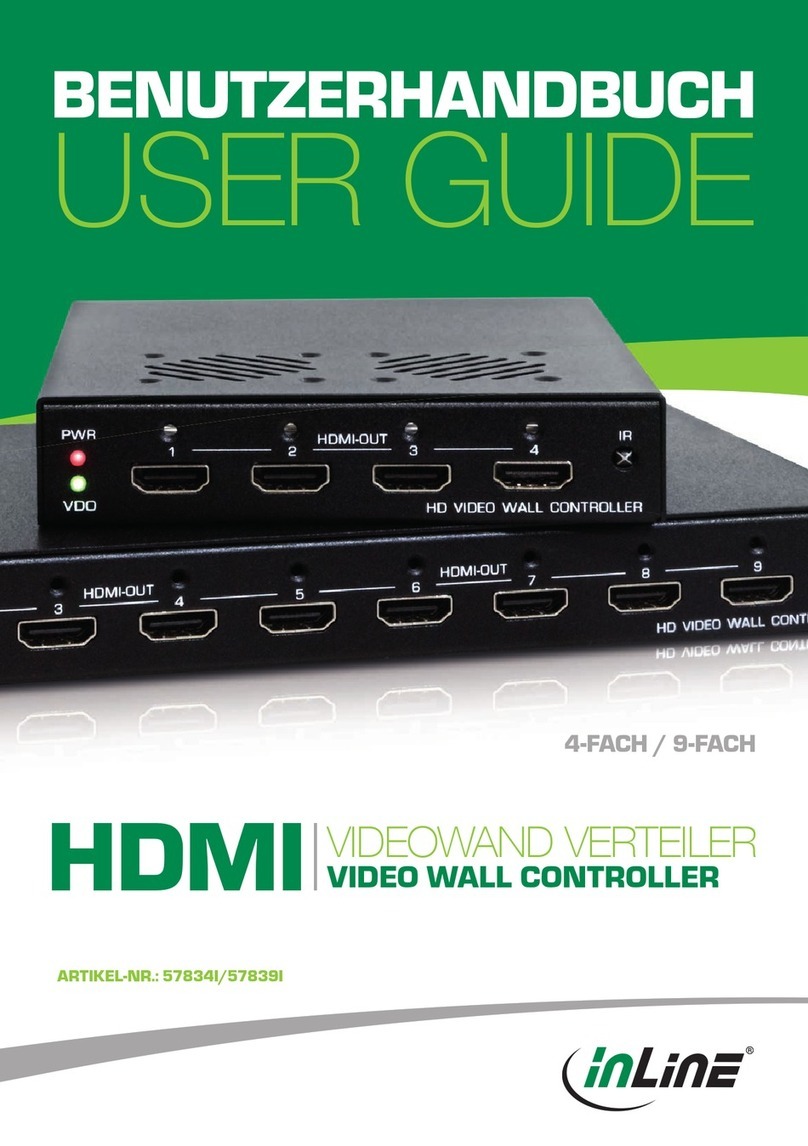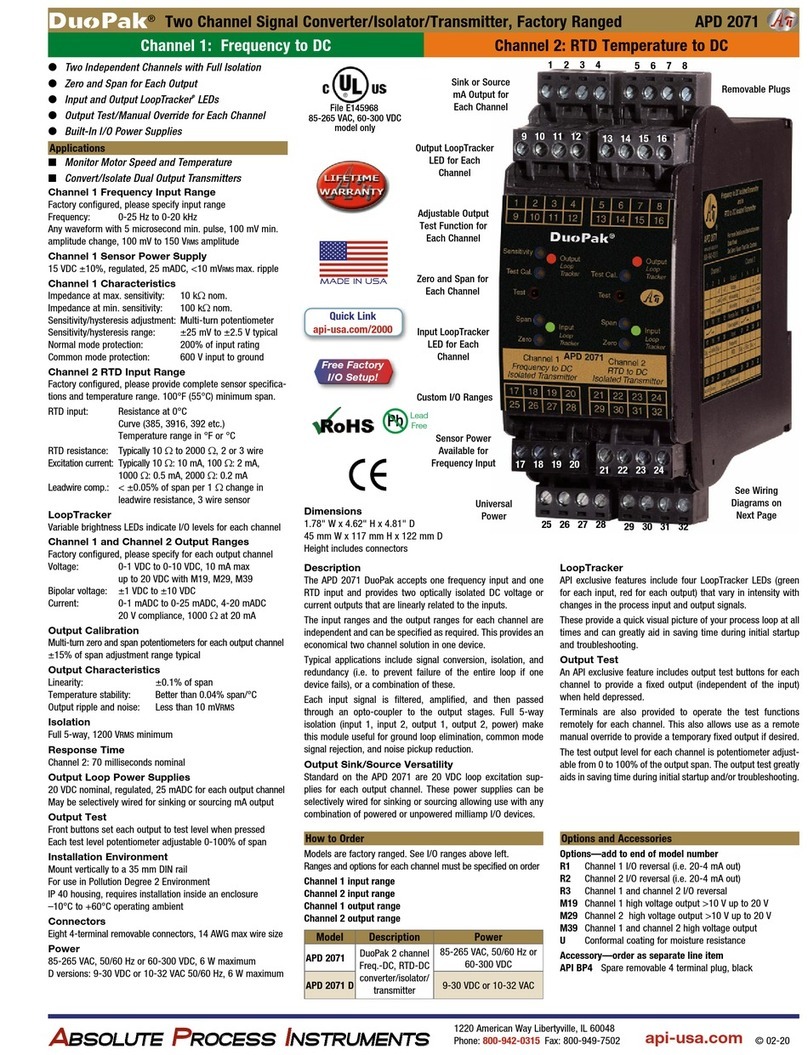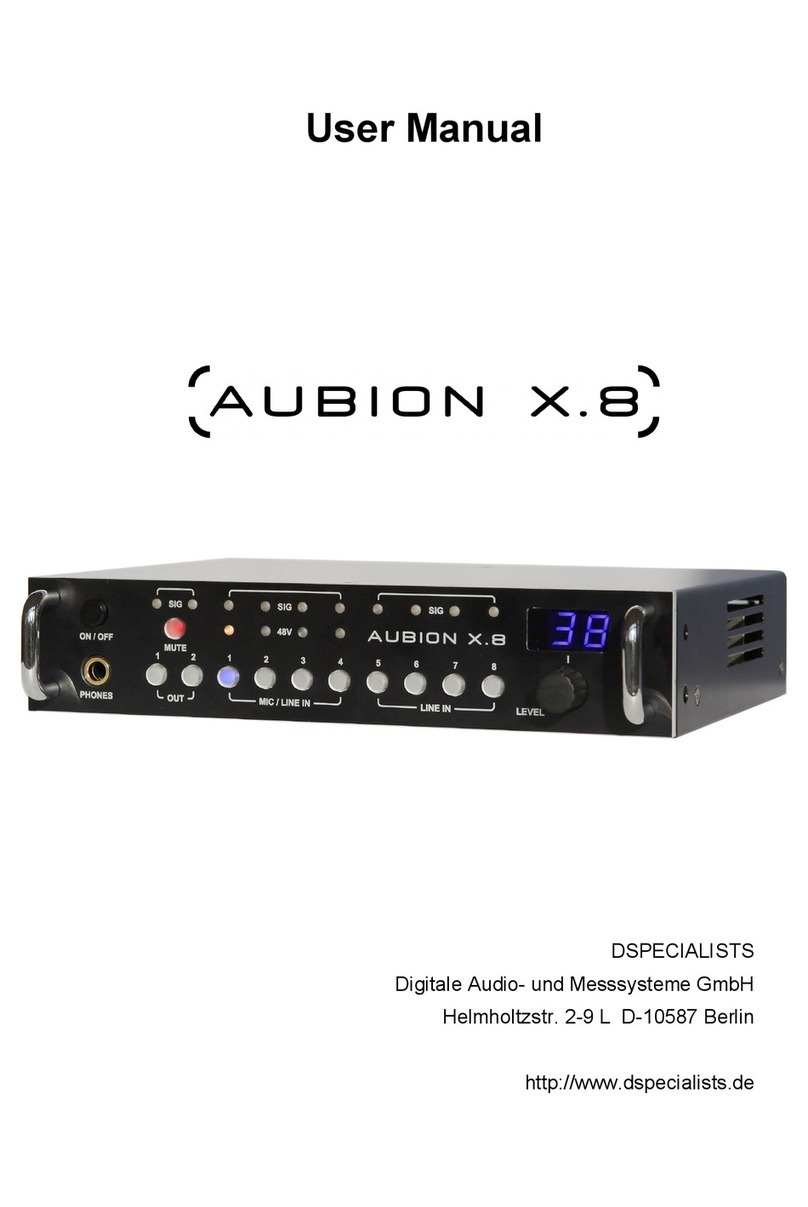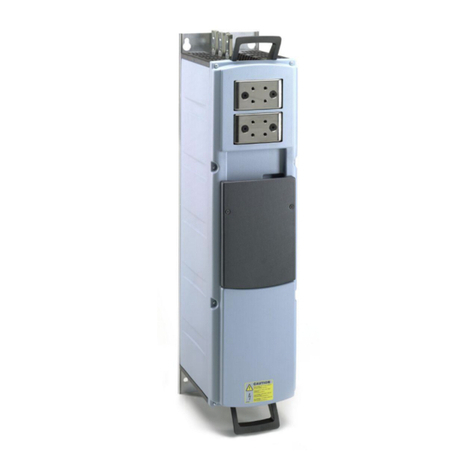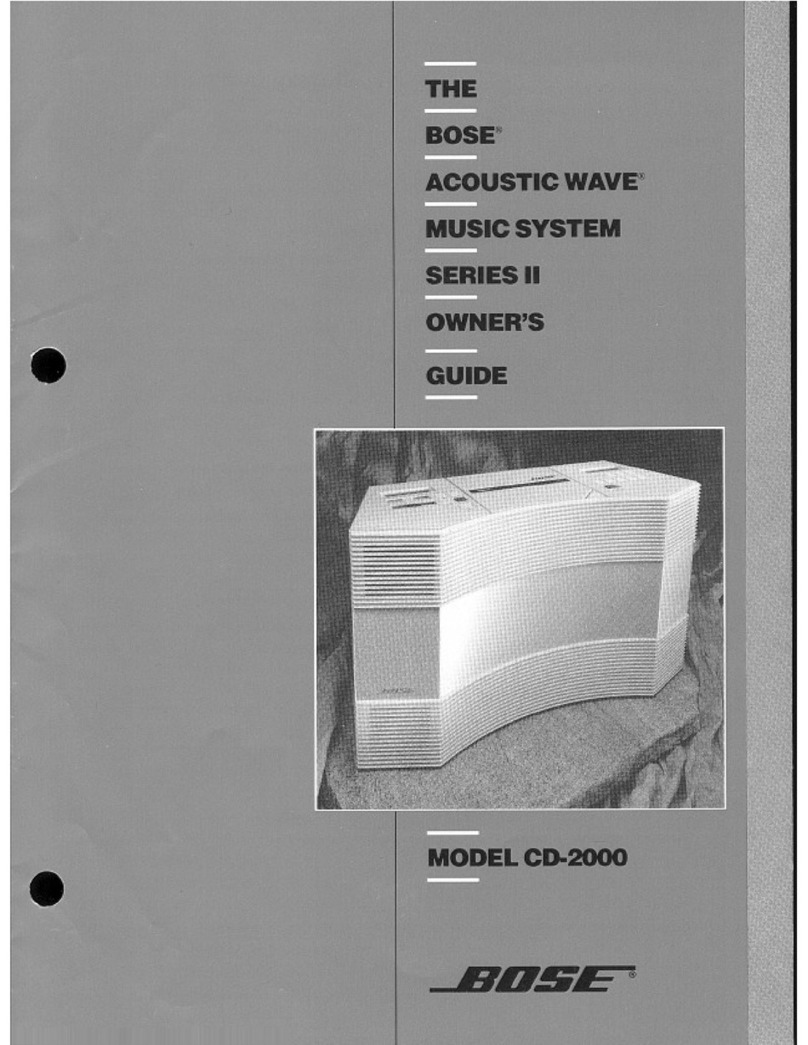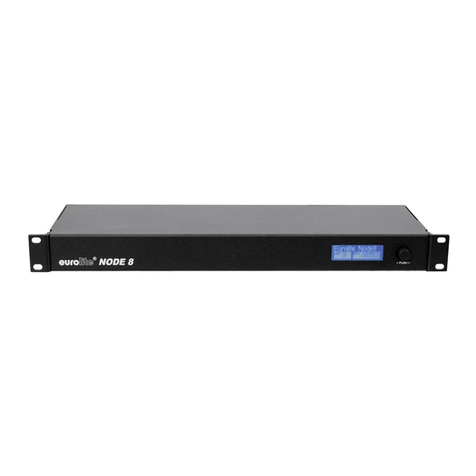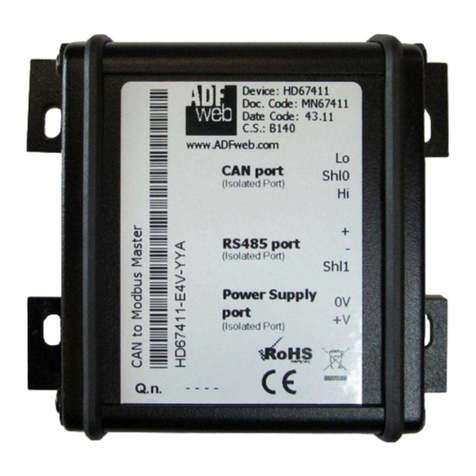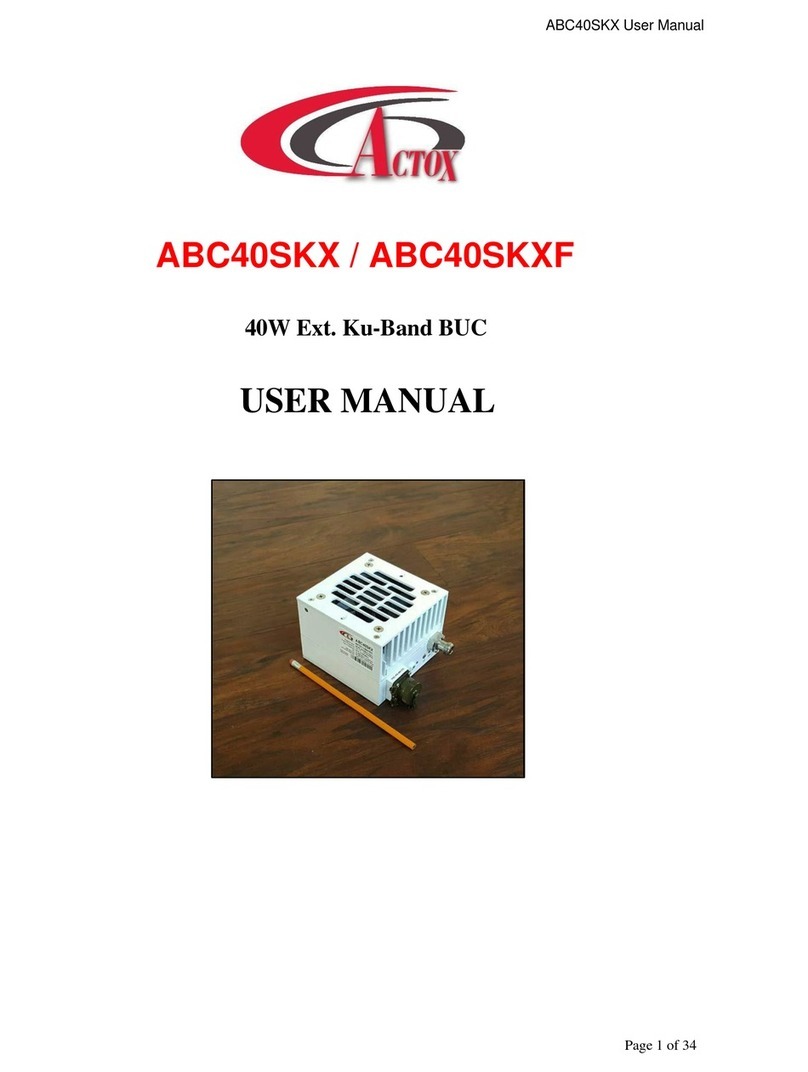RKC INSTRUMENT COM-JL User manual

Ethernet [Modbus/TCP] Communication Converter
IMR01Y05-E3
Thank you for purchasing this RKC product. In order to achieve maximum
performance and ensure proper operation of your new instrument, carefully read all
the instructions in this manual. Please place this manual in a convenient location for
easy reference.
This manual describes the handling precautions, mounting, wiring and specifications
only. For the basic operations, see COM-JL [For FB100/FB400/FB900] Quick
Instruction Manual (IMR01Y15-E). For the detail handling procedures and various
function settings, please refer to separate COM-JL [For FB100/FB400/FB900]
Instruction Manual (IMR01Y10-E).
The above manuals can be downloaded from our website:
URL: http://www.rkcinst.com/english/manual_load.htm
Product Check
Safety Precautions
zThis product is intended for use with industrial machines, test and measuring
equipment. (It is not designed for use with medical equipment and nuclear energy.)
zThis is a Class A instrument. In a domestic environment, this instrument may cause
radio interference, in which case the user may be required to take additional
measures.
zThis instrument is protected from electric shock by reinforced insulation. Provide
reinforced insulation between the wire for the input signal and the wires for
instrument power supply, source of power and loads.
zBe sure to provide an appropriate surge control circuit respectively for the following:
−If input/output or signal lines within the building are longer than 30 meters.
−If input/output or signal lines leave the building, regardlessthe length.
zThis instrument is designed for installation in an enclosed instrumentation panel. All
high-voltage connections such as power supply terminals must be enclosed in the
instrumentation panel to avoid electricshock by operating personnel.
zAll precautions described in this manual should be taken to avoid damage to the
instrument or equipment.
zAll wiring must be in accordance with local codes and regulations.
zTo prevent instrument damage or failure, protect the power line and the input/output
lines from high currents with a protection device such as fuse, circuit breaker, etc.
zPrevent metal fragments or lead wire scraps from falling inside instrument case to
avoid electric shock, fire or malfunction.
zTighten each terminal screw to the specified torque found in the manual to avoid
electric shock, fire or malfunction.
zFor proper operation of this instrument, provide adequate ventilation for heat
dispensation.
zDo not connect wires to unused terminals as this will interfere with proper
operation of the instrument.
zTurn off the power supply before cleaning the instrument.
zDo not use a volatile solvent such as paint thinner to clean the instrument.
Deformation or discoloration will occur. Use a soft, dry cloth to remove stains from
the instrument.
zTo avoid damage to instrument display, do not rub with an abrasive material or
push front panel with a hard object.
zDo not connect modular connectors to telephone line.
NOTICE
zThis manual assumes that the reader has a fundamental knowledge of the
principles of electricity, process control, computer technologyand communications.
zThe figures, diagrams and numeric values used in this manual are only for purpose
of illustration.
zRKC is not responsible for any damage or injury that is caused as a result of using
this instrument, instrument failure or indirect damage.
zRKC is not responsible for any damage and/or injury resulting from the use of
instruments made by imitating this instrument.
zPeriodic maintenance is required for safe and proper operation of this instrument.
Some components have a limited service life, or characteristics that change over
time.
zEvery effort has been made to ensure accuracy of all information contained herein.
RKC makes no warranty expressed or implied, with respect to the accuracy of the
information. The information in this manual is subject to change without prior notice.
zNo portion of this document may be reprinted, modified, copied, transmitted,
digitized, stored, processed or retrieved through any mechanical, electronic, optical
or other means without prior written approval from RKC.
1. MOUNTING
1.1 Mounting Cautions
(1) This instrument is intended to be used under the following environmental
conditions. (IEC61010-1) [OVERVOLTAGECATEGORYII,POLLUTIONDEGREE2]
(2) Use this instrument within the following environment conditions:
•Allowable ambient temperature: −10 to +50 °C
•Allowable ambient humidity: 5 to 95 % RH
(Absolute humidity: MAX. W. C 29.3 g/m3dry air at 101.3 kPa)
•Installation environment conditions: Indoor use
Altitude up to 2000 m
(3) Avoid the following conditions when selecting the mounting location:
•Rapid changes in ambient temperature which may cause condensation.
•Corrosive or inflammable gases.
•Direct vibration or shock to the mainframe.
•Water, oil, chemicals, vapor or steam splashes.
•Excessive dust, salt or iron particles.
•Excessive induction noise, static electricity, magnetic fields or noise.
•Direct air flow from an air conditioner.
•Exposure to direct sunlight.
•Excessive heat accumulation.
(4) Mount this instrument in the panel considering the following conditions:
•Ensure at least 50 mm space on top and bottom of the instrument for maintenance
and environmental reasons.
•Do not mount this instrument directly above equipment that generates large
amount of heat (heaters, transformers, semi-conductor functional devices,
large-wattage resistors).
•If the ambient temperature rises above 50 °C, cool this instrument with a forced air
fan, cooler, etc. Cooled air should not blow directly on this instrument.
•In order to improve safety and the immunity to withstand noise, mount this
instrument as far away as possible from high voltage equipment, power lines, and
rotating machinery.
High voltage equipment: Do not mount within the same panel.
Power lines: Separate at least 200 mm.
Rotating machinery: Separate as far as possible.
(5) If this instrument is permanently connected to equipment, it is important to include a
switch or circuit-breaker into the installation. This should be in close proximity to the
equipment and within easy reach of the operator. It should be marked as the
disconnecting device for the equipment.
1.2 Dimensions
330
109.5
125
78
5
(Unit: mm)
1.3 DIN rail Mounting
Mounting procedures
1. Pull down the mounting bracket at the bottom of the instrument (A). Attach the
hooks on the top of the instrument to the DIN rail and push the lower section into
place on the DIN rail (B).
2. Slide the mounting bracket up to secure the instrument to the DIN rail (C).
Removal procedures
Pull down a mounting bracket with a blade screwdriver (A). Lift the instrument from
bottom, and take it off (B).
1.4 Panel Mounting
Mounting procedures
1. Pull down the mounting bracket (A) until locked and that a mounting hole appears.
2. Prepare one mounting bracket per instrument (B) sold separately (KSRX-55) and
then insert it in the rear of the terminal board at top of the instrument until locked
but a mounting hole does not disappear.
3. Mount each module directly on the panel with screws which are inserted in the
mounting holes of the top and bottom mounting brackets.
Recommended tightening torque: 0.3 N⋅m (3 kgf⋅cm)
The customer needs to provide the M3 size screws. Select the screwlength
that matches the mounting panel.
(A) Pull down
(B) Insert
Mounting bracket
(Sold separately)
(KSRX-55)
Mounting
holes
Mounting dimensions
130.5 ±0.2
M3
(Unit: mm)
2. WIRING
2.1 Wiring Cautions
•To avoid noise induction, keep communication signal wire away from instrument
power line, load lines and power linesof other electric equipment.
•If there is electrical noise in the vicinity of the instrument that could affect
operation, use a noise filter.
−Shorten the distance between the twisted power supply wire pitches to
achieve the most effective noise reduction.
−Always install the noise filter on a grounded panel. Minimize the wiring
distance between the noise filter output and the instrument power supply
terminals to achieve the most effective noise reduction.
−Do not connect fuses or switches to the noise filter output wiring as this will
reduce the effectiveness of the noise filter.
•Power supply wiring must be twisted and have a low voltage drop.
•For an instrument with 24 V power supply, supply power from a SELVcircuit.
•A suitable power supplyshould be considered in end-use equipment. The power
supply must be in compliance with a limited-energycircuits (maximum available
current of 8 A).
•Use the solderless terminal appropriate to the screw size (M3).
•Make sure that the any wiring such as solderless terminal is not in contact with
the adjoining terminals.
2.2 Terminal Configuration
+−
24 V
DC
12
9 8
FG
Controller
communication
T/R(B)
T/R(A)
RS-485
1
5SG
4
Upper-side
terminal
Lower-side
terminal
Power supply Ground
2 1
7 6 5 4
14 13 12
11 10 9 8
3
: The part of internal wiring
•As controller communication terminal Nos. 1, 4 and 5 are internally connected
to terminal Nos. 3, 6and 7, any terminals can be used.
•As ground and power supply terminal Nos. 8, 9 and 12 are internally
connected to terminal Nos. 10, 11 and 14, any terminals can be used.
•Terminal No. 2 and No. 13 is not used.
CO
M
-
JL
COM-JL [For FB100/FB400/FB900] Installation Manual (this manual)....................1
COM-JL [For FB100/FB400/FB900] Quick Instruction Manual (IMR01Y15-E) ....1
COM-JL [For FB100/FB400/FB900] Communication Data List (IMR01Y21-E)....1
All Rights Reserved, Copyright ©2006, RKC INSTRUMENT INC.
(B) Push
Mounting
bracket
DIN rail
(A) Pull down (C) Locked
(A) Pull down
(B) Lift and
take off
5.9 mm or less
3.2 mm or more
Recommended tightening torque:
0.4 N⋅m (4 kgf⋅cm)
zAn external protection device must be installed if failure of this instrument
could result in damage to the instrument, equipment or injury to personnel.
zAll wiring must be completed before power is turned on to prevent electric
shock, fire or damage to instrument and equipment.
zThis instrument must be used in accordance with the specifications to
prevent fire or damage to instrument and equipment.
zThis instrument is not intended for use in locations subject to flammable or
explosive gases.
zDo not touch high-voltage connections such as power supply terminals,
etc. to avoid electric shock.
zRKC is not responsible if this instrument is repaired, modified or
disassembled by other than factory-approved personnel. Malfunction can
occur and warranty is void under these conditions.
!WARNING
CAUTION
To prevent electric shock or instrument failure, always turn off the
power before mounting or removing the instrument.
!WARNING
To prevent electric shock or instrument failure, do not turn on the
power until all wiring is completed. Make sure that the wiring is
correct before applying power to the instrument.
!WARNING
Installation
Manual
[For FB100/FB400/FB900]

The first edition: MAY 2006 [IMQ00]
The third edition: FEB 2009 [IMQ00]
®
RKC INSTRUMENT INC.
HEADQUARTERS: 16-6, KUGAHARA 5-CHOME, OHTA-KU TOKYO 146-8515 JAPAN
PHONE: 03-3751-9799 (+81 3 3751 9799) E-mail: info@rkcinst.co.jp
FAX: 03-3751-8585 (+81 3 3751 8585) FEB. 2009
Ethernet is a registered trademark of Xerox Corp.
Modbus is a registered trademark of Schneider Electric
Company names and product names used in this manual are the trademarks or registered
trademarks of the respective companies.
2.3 Connection to Ethernet
Pin layout of connector
Pin layout
Modular connecto
r
for Ethernet
RJ-45
1
8
Pin No. Signal name Symbol
1 Send data +TX+
2 Send data −TX−
3 Receive data +RX+
4 Unused ⎯
5 Unused ⎯
6 Receive data −RX−
7 Unused ⎯
8 Unused ⎯
The cable must be provided by the customer.
Used cable: The cable is based on the 10BASE-T or the
100BASE-TX standard of Ethernet.
Used connector: RJ-45 type
Wiring example
zWhen directly connected to client
Use a cross cable when directly connected to the client (such as computer).
TX+
TX−
RX+
RX−
TX+
TX−
RX+
RX−
Computer COM-JL
Cross cable
zWhen use network hub
Use straight cables when connected to the network hub.
Network hub
TX+
TX−
RX+
RX−
TX+
TX−
RX+
RX−
TX+
TX−
RX+
RX−
TX+
TX−
RX+
RX−
Computer COM-JL
Straight cable Straight cable
Cross cables may be used depending on the connecting device used.
Therefore, follow the instructions for the respective device.
2.4 Connection to the Controllers
Conduct wiring between the COM-JL and controller (FB100/400/900) as shown in the
following. (When conducting wiring to the FB100/400/900, always conduct wiring to
the Communication 1 terminal.)
RS-485
y
y
y
Paired wire
Shielded twisted
pair wire
FB400/900
Communication terminals
(communication 1 side)
FB400/900
Maximum controller connections: 31 controllers
*R
*R: Termination resistors (Example: 120 Ω1/2 W)
25
T/R (B)
T/R (A)
26
27
SG
25
T/R (B)
T/R (A)
26
27
SG
COM-JL
T/R (A)
SG
T/R (B)
4
1
5
*R
Terminal block
Communication terminals
(communication 1 side)
(
+
)
(−)
(
+
)
(−)
(
+
)
(−)
Communication 1 terminals of controller
Terminal No.
FB100 FB400/900 Symbol
13 25 SG
14 26 T/R (A)
15 27 T/R (B)
•The cable must be provided by the customer.
•The termination resistor existing within the COM-JL can be connected or
disconnected by the switch. (Factory set value: Termination resistor connected)
2.5 System Configuration Example
When directly connected to client
Power supply (24 V DC)
FB100, FB400 or FB900
(Up to 31 controllers)
FB100
FB400
FB900
1
FB100
FB400
FB900
2
FB100
FB400
FB900
31
Controller communication (RS-485: Modbus)
Ethernet
Computer
(Client)
Ethernet
[Modbus/TCP]
communication
converter COM-JL
(Server)
When use network hub
Power supply (24 V DC)
FB100, FB400 or FB900
(Up to 31 controllers)
FB100
FB400
FB900
1
FB100
FB400
FB900
2
FB100
FB400
FB900
31
Controller communication (RS-485: Modbus)
Ethernet
Network hub
Computer
(Client)
Ethernet
Ethernet
[Modbus/TCP]
communication
converter COM-JL
(Server)
The data request side (such as computer) is called Client and the data
response (supply) side (COM-JL) is called Server.
Basically, one Client corresponds to one Server (COM-JL) (i.e. one to one).
However, one Client can communicate with two or more Servers
depending on the program on the Client side, but two or more Clients
cannot communicate with one Server.
3. SPECIFICATIONS
Ethernet communication
Physical layer: Ethernet
10BASE-T/100BASE-TX automatic recognition
Application layer: Modbus/TCP
Communication data: Based on Modbus message format
Connector type: RJ-45
Controller communication
Interface: Based on RS-485, EIA standard
Protocol: Modbus-RTU
Communication speed: 9600 bps, 19200 bps, 38400 bps
Data bit configuration: Data 8-bit, Without parity, Stop 1-bit
Maximum connections: 31 controllers (FB100/400/900)
General specifications
Power supply voltage: 24 V DC
Power supply voltage range:
21.6 to 26.4 V DC
Current consumption: 110 mA max.
Allowable ambient temperature:
−10 to +50 °C
Allowable ambient humidity:
5 to 95 %RH
(Absolute humidity: MAX.W.C 29.3 g/m3dry air at 101.3 kPa)
Installation environment conditions:
Indoor use
Altitude up to 2000 m
Weight: Approx. 180 g
Standard
Safety standard: UL: UL61010-1
cUL: CAN/CSA-C22.2 No.61010-1
CE marking: LVD: EN61010-1
EMC: EN61326
C-Tick: AS/NZS CISPR11 (equivalent to EN55011)
4. MODEL CODE
COM-JL-1 01
(1) (2)
(1) Communication type
1: Modbus/TCP
(2) Corresponding to the RKCcontroller
01: FB100/400/900
*
Other manuals for COM-JL
3
Other RKC INSTRUMENT Media Converter manuals
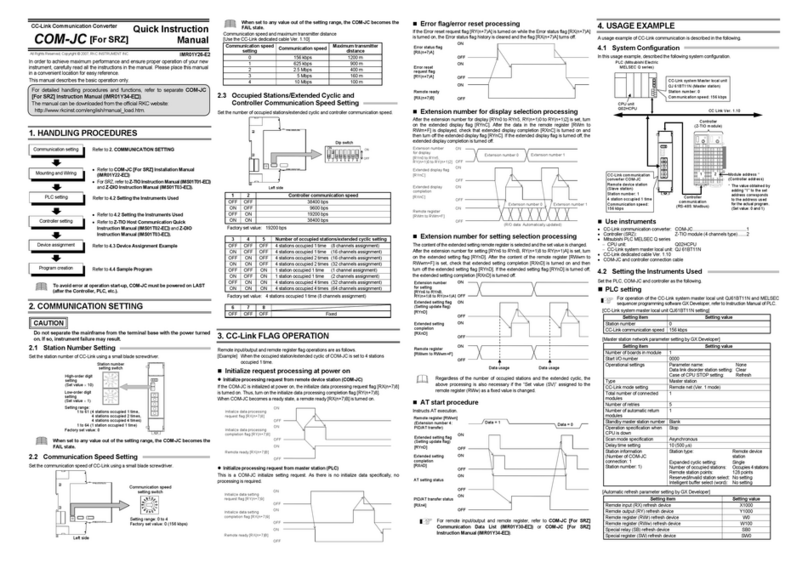
RKC INSTRUMENT
RKC INSTRUMENT COM-JC User manual
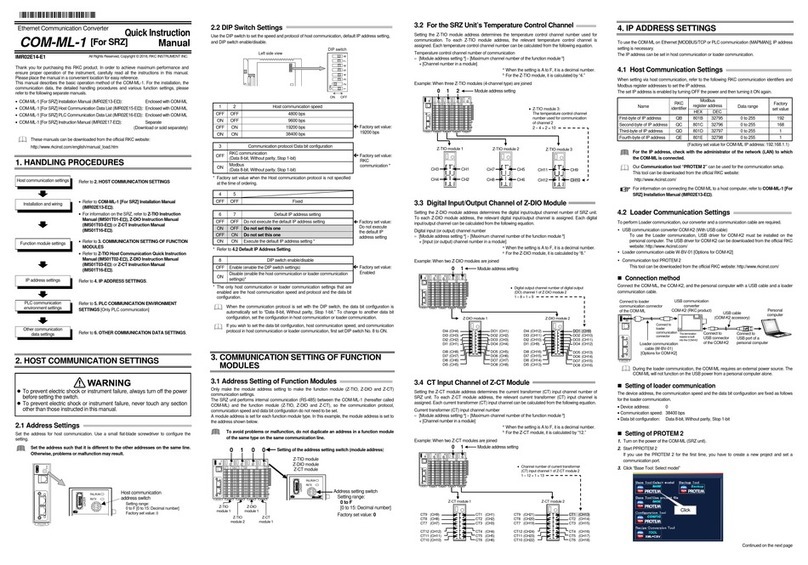
RKC INSTRUMENT
RKC INSTRUMENT COM-ML-1 User manual

RKC INSTRUMENT
RKC INSTRUMENT COM-JC User manual
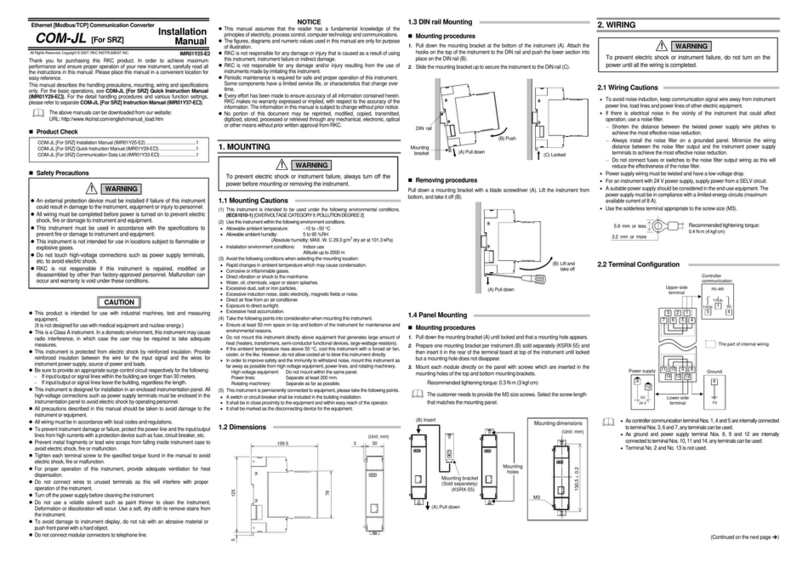
RKC INSTRUMENT
RKC INSTRUMENT COM-JL User manual
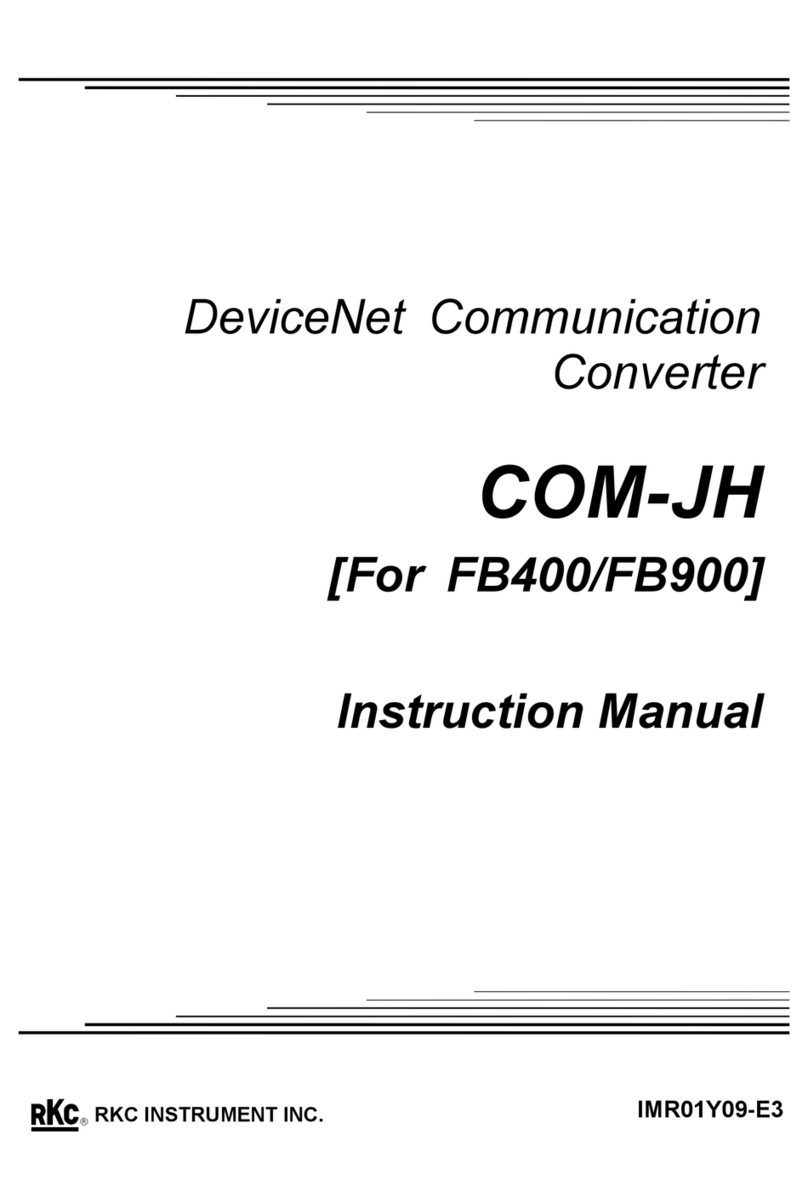
RKC INSTRUMENT
RKC INSTRUMENT DeviceNet COM-JH User manual
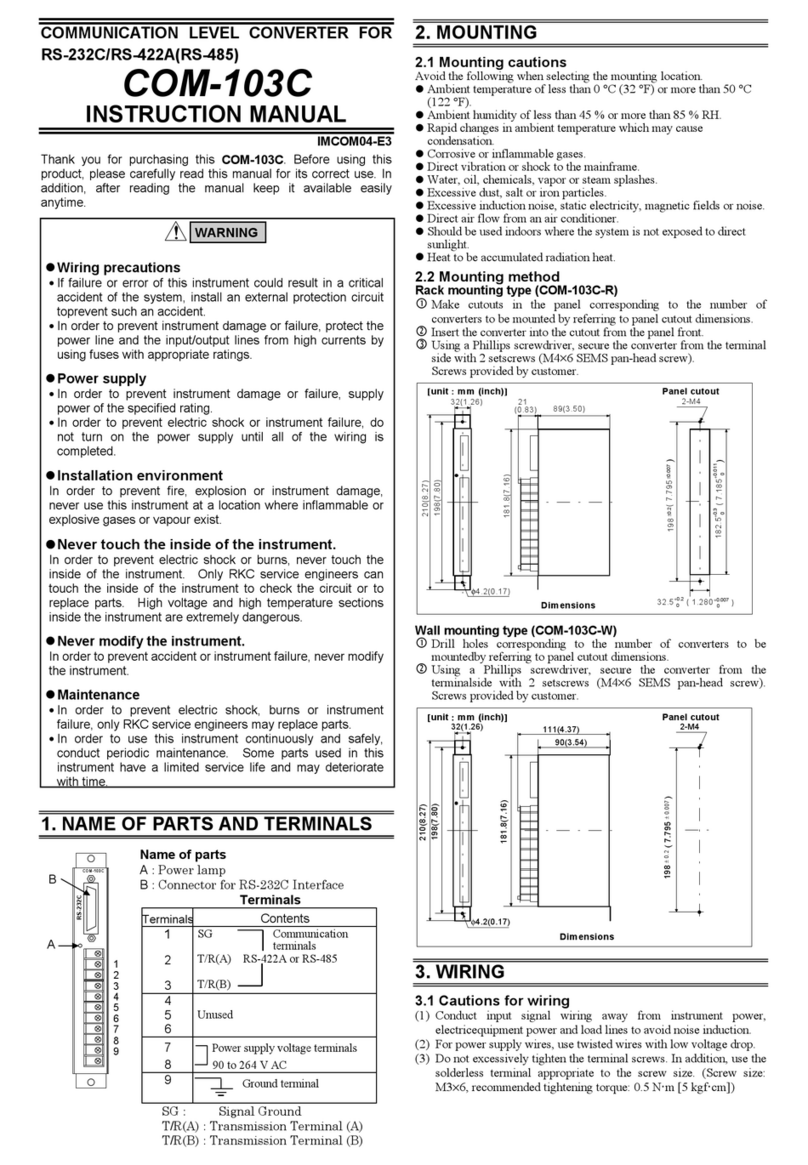
RKC INSTRUMENT
RKC INSTRUMENT COM-103C User manual
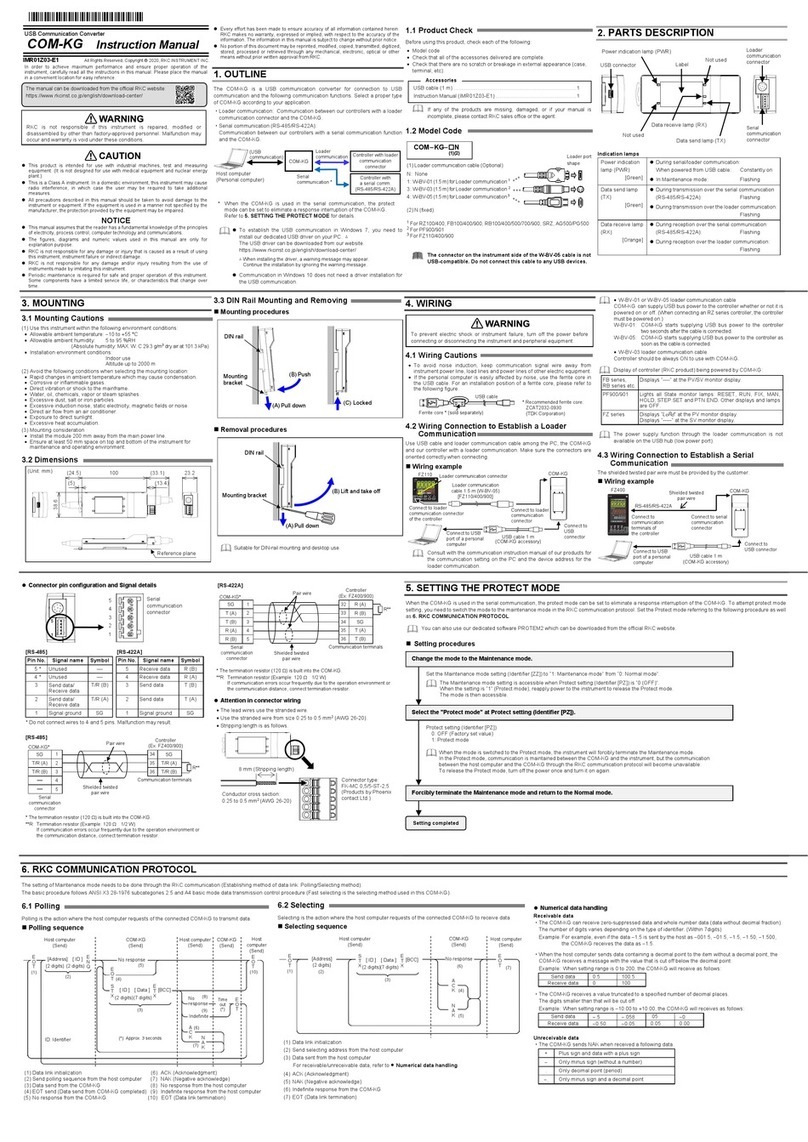
RKC INSTRUMENT
RKC INSTRUMENT COM-KG User manual
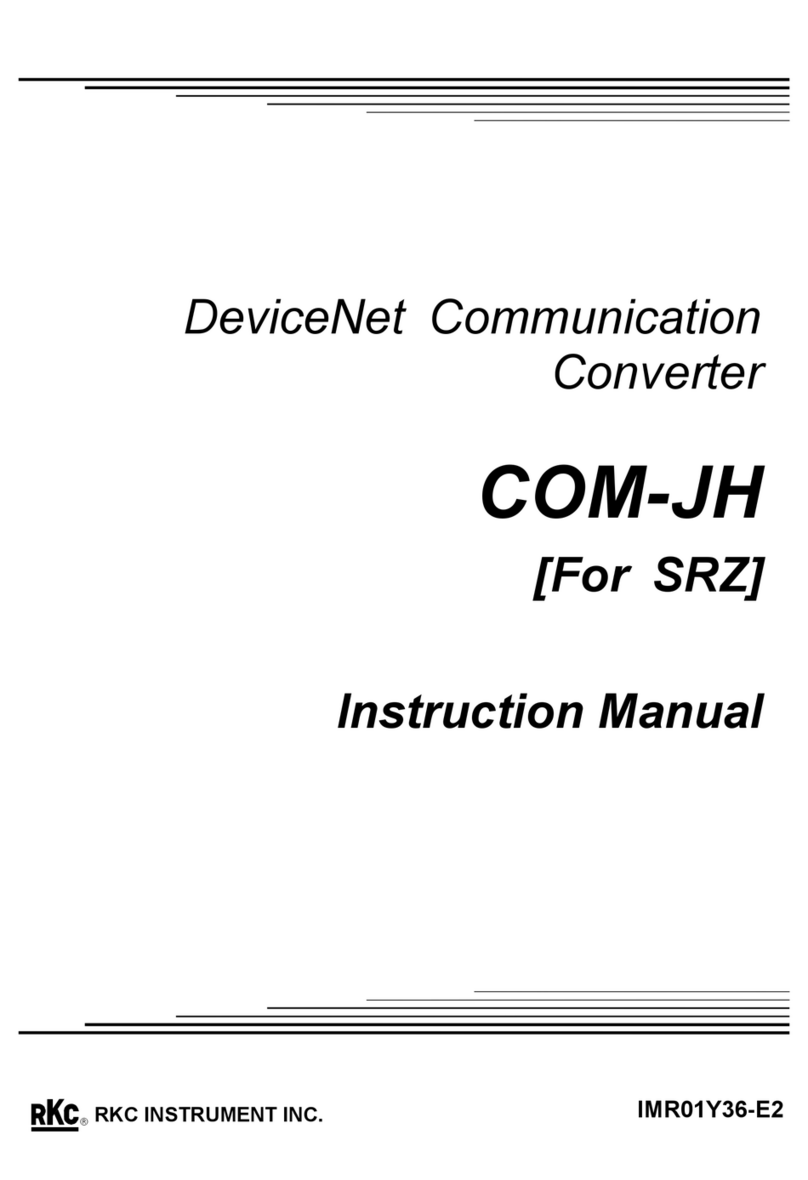
RKC INSTRUMENT
RKC INSTRUMENT COM-JH User manual
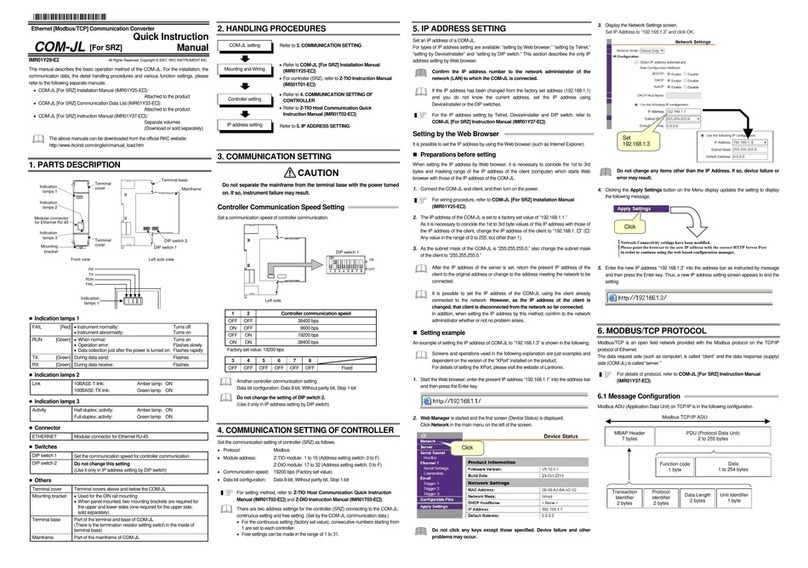
RKC INSTRUMENT
RKC INSTRUMENT COM-JL User manual

RKC INSTRUMENT
RKC INSTRUMENT COM-JL User manual

